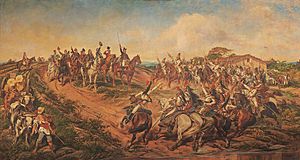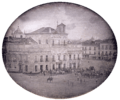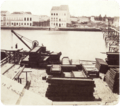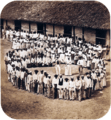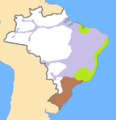Empire of Brazil facts for kids
Quick facts for kids
Empire of Brazil
Império do Brasil
|
|
|---|---|
| 1822–1889 | |
|
Motto: Independência ou Morte!
"Independence or Death!" |
|
|
Anthem: Anthem of Independence(1822-1831)
Brazilian National Anthem (1831–1889) |
|

The Empire of Brazil including the former Cisplatina province.
|
|
| Capital | Rio de Janeiro 22°54′30″S 43°11′47″W / 22.90833°S 43.19639°W |
| Common languages | Portuguese |
| Religion | Roman Catholic |
| Government | Constitutional monarchy parliamentary unitary state representative democracy |
| Emperor of Brazil | |
|
• 1822–1831
|
Pedro I |
|
• 1831–1889
|
Pedro II |
| Legislature | General Assembly |
| Senate | |
| Chamber of Deputies | |
| Historical era | 19th century |
|
• Independence
|
7 September 1822 |
|
• Accession of Pedro I
|
12 October 1822 |
|
• Imperial Constitution adopted
|
25 March 1824 |
|
• Accession of Pedro II
|
7 April 1831 |
|
• Slavery abolished
|
13 May 1888 |
|
• Monarchy abolished
|
15 November 1889 |
| Currency | Real |
| ISO 3166 code | BR |
The Empire of Brazil was a country in South America during the 1800s. It was a constitutional monarchy, which means it had an emperor as its leader, but his power was limited by a constitution and a parliament. The Empire covered the land that is now Brazil and Uruguay.
Brazil was once a colony of the Portuguese Empire. In 1808, the Portuguese royal family, led by João VI, moved to Brazil to escape a French invasion of Portugal. This made Brazil the center of the Portuguese Empire for a while. When João returned to Portugal, he left his son Pedro in charge of Brazil.
Contents
Brazil Becomes Independent
On September 7, 1822, Pedro declared Brazil to be an independent Empire. The people cheered him on, and he became Emperor Pedro I. This was a huge step for Brazil, as it was no longer a colony.
The Reign of Pedro I
Pedro I ruled for several years. However, in 1831, he decided to return to Portugal. He gave up his role as Emperor of Brazil and left his young son, Pedro II, to become the next emperor.
Pedro II's Long Rule
Pedro II became emperor when he was very young. His time as emperor was long and important for Brazil. During his rule, Brazil experienced many years of economic growth and political stability. The country also fought in three international wars.
Ending Slavery in Brazil
The imperial family of Brazil, including Emperor Pedro I and Emperor Pedro II, wanted to end slavery. This was a big goal for them.
The Golden Law
On May 13, 1888, Princess Isabel signed a very important document called the Golden Law. She signed it on behalf of her father, Emperor Pedro II. This law officially ended slavery in Brazil. At that time, Brazil was one of the last major countries in the world to abolish slavery.
The End of the Empire
Some plantation owners were unhappy about slavery being abolished. They joined a movement that wanted Brazil to become a republic instead of an empire. This movement was led by Deodoro da Fonseca, a military leader.
A New Government
On November 15, 1889, a coup happened, which means the government was taken over by force. The empire was ended, and Brazil became a republic. The imperial family was sent away from Brazil. Those who disagreed with the new government faced difficulties.
Images for kids
-
Recife, capital of Pernambuco (Brazilian northeast), two years after the end of the Praieira revolt
-
A locomotive in Bahia province (Brazilian northeast), c. 1859
-
Brazilian artillery in position during the Paraguayan War, 1866
-
Slaves on a farm in the province of Minas Gerais, 1876
-
A few moments after signing the Golden Law, Princess Isabel is greeted from the central balcony of the City Palace by a huge crowd below in the street
-
19th-century Brazilians. 1st row: White Brazilians. 2nd row: Brown Brazilians (left to right: two female mulattoes, two female cafuzos and a caboclo girl and man). 3rd row: three Brazilian Indians of different tribes followed by Afro-Brazilians of distinct ethnic background
-
Brazilian friars c. 1875
-
A photograph dating from c. 1858, showing three major Brazilian Romantic writers. From left to right: Gonçalves Dias, Manuel de Araújo Porto Alegre and Gonçalves de Magalhães
See also
 In Spanish: Imperio del Brasil para niños
In Spanish: Imperio del Brasil para niños




